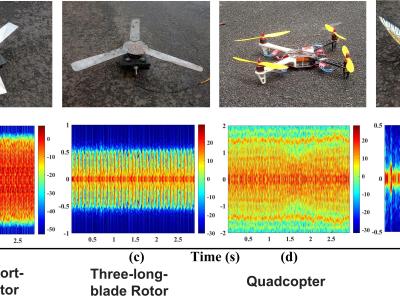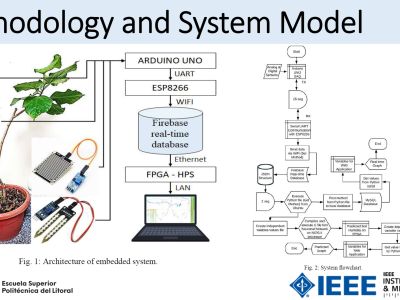DIAT-µSAT: micro-Doppler Signature Dataset of Small Unmanned Aerial Vehicle (SUAV)

- Citation Author(s):
-
Harish Chandra Kumawat
(Defence Institute of Advanced Technology (DIAT), Girinagar, Pune 411025, India)
- Submitted by:
- Harish Kumawat
- Last updated:
- DOI:
- 10.21227/1x2q-8v62
- Data Format:
- Research Article Link:
- Links:
Abstract
Due to the smaller size, low cost, and easy operational features, small unmanned aerial vehicles (SUAVs) have become more popular for various defense as well as civil applications. They can also give threat to national security if intentionally operated by any hostile actor(s). Since all the SUAV targets have a high degree of resemblances in their micro-Doppler (m-D) space, their accurate detection/classification can be highly guaranteed by the appropriate deep convolutional neural network (DCNN) architecture. In this work, an indigenously developed continuous wave (CW) (X-band: 10 GHz) radar is used to build a diversified “DIAT-µSAT” dataset comprising 4849 micro-Doppler signature images of SUAV targets: RC plane, three-short-blade rotor, three-long-blade rotor, quadcopter, bionic bird, and mini-helicopter + bionic bird. All the SUAV targets are operated at different speeds/orientations/rates as follows—revolution per minute (RPM): 200–1740 RPM, flapping rates: 2–4 flaps/s, azimuth angles: 0◦–360◦ at the angle resolution of 45◦, and elevation angles: 0◦–90◦ at the angle resolution of 30◦, tilted (with respect to radar’s boresight) target positions, so as to ensure the diversification in our dataset.
Instructions:
In our dataset, the total number of spectrogram images generated using the open-field experiments is 4849, and the class-wise details can be found in our journal articles (1) H. C. Kumawat, M. Chakraborty, A. A. Bazil Raj and S. V. Dhavale, "DIAT-μSAT: Small Aerial Targets’ Micro-Doppler Signatures and Their Classification Using CNN," in IEEE Geoscience and Remote Sensing Letters, vol. 19, pp. 1-5, 2022, Art no. 6004005, doi: 10.1109/LGRS.2021.3102039. (2) H. C. Kumawat, M. Chakraborty and A. A. B. Raj, "DIAT-RadSATNet—A Novel Lightweight DCNN Architecture for Micro-Doppler-Based Small Unmanned Aerial Vehicle (SUAV) Targets’ Detection and Classification," in IEEE Transactions on Instrumentation and Measurement, vol. 71, pp. 1-11, 2022, Art no. 8504011, doi: 10.1109/TIM.2022.3188050.
To download the .mat files, for the free educational access, please send an e-mail request to "brazilraj.a@diat.ac.in" and "sunitadhavale@diat.ac.in" mentioning the subject: “DIAT-μSAT Dataset Educational Access Request” from their institutional e-mail id.
The DIAT-μSAT dataset is completely open to academic research. To use the dataset, please cite the following base/original papers:
(1) H. C. Kumawat, M. Chakraborty, A. A. Bazil Raj and S. V. Dhavale, "DIAT-μSAT: Small Aerial Targets’ Micro-Doppler Signatures and Their Classification Using CNN," in IEEE Geoscience and Remote Sensing Letters, vol. 19, pp. 1-5, 2022, Art no. 6004005, doi: 10.1109/LGRS.2021.3102039.
(2) H. C. Kumawat, M. Chakraborty and A. A. B. Raj, "DIAT-RadSATNet—A Novel Lightweight DCNN Architecture for Micro-Doppler-Based Small Unmanned Aerial Vehicle (SUAV) Targets’ Detection and Classification," in IEEE Transactions on Instrumentation and Measurement, vol. 71, pp. 1-11, 2022, Art no. 8504011, doi: 10.1109/TIM.2022.3188050.
 6788 views
6788 views








Please proide me the access . I want to use the dataset for classfication.
We have IEEE /ASPP/POP subscription...Kindly send us the above datasets. 'Thnaks
want to use it for classificaion
Dear,
I am writing to formally request access to the author dataset.
The author dataset you manage is of significant interest to my study, as it provides a comprehensive collection of metadata that is crucial for the performance and accuracy evaluation of the algorithm. The objective of my research is to contribute novel insights to the field of drone detection algorithms, and I believe that your dataset will play a pivotal role in achieving this goal.
Please be assured that your dataset will be used strictly for academic purposes, and the results derived from it will be properly cited. Additionally, should any publications arise from this research, the use of your dataset will be duly acknowledged as per the guidelines of your institution.
I kindly ask you to provide the necessary access permissions and any relevant information that may assist in the appropriate utilization of the dataset.
Thank you for considering my request. I am happy to provide any further details or documentation you might require.
Sincerely,
I would kindly ask the authors to provide necessary data files as it would be a great help for our team for which would be implemented in a personal ML project.
Kindly send the necessary files at: connect.davuluri@gmail.com
I would like to use this data for classification tasks.
.